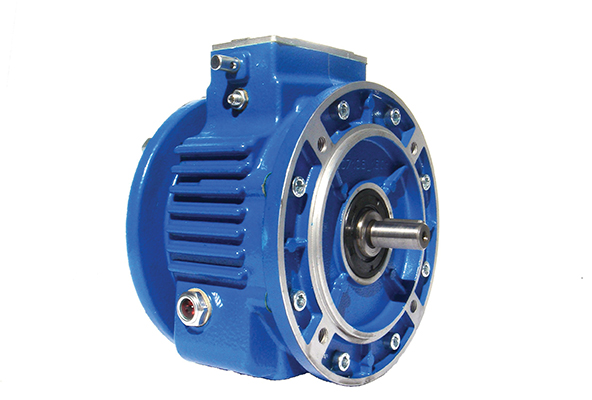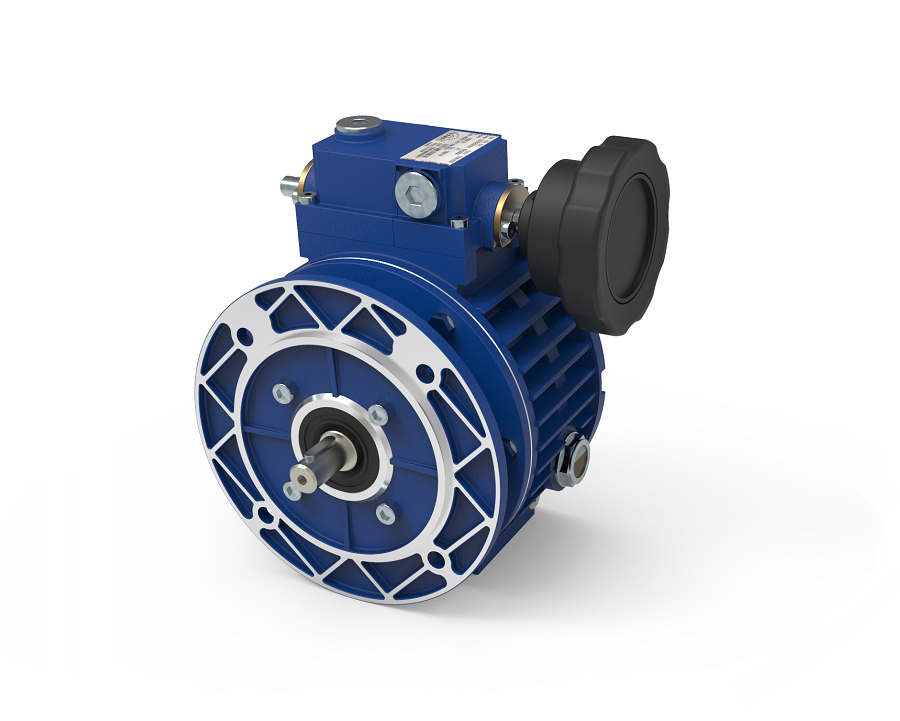Product Description
1) High precision of speed regulating for speed variator,UD gear box: up to 0.5-1 round
2) Large speed-changing range: the speed ratio ranges from 1:1.4 to 1:7 freely
3) High intensity and long serving time
4) Convenient to regulate speed
5) Continuously workable, bidirectional working direction,smooth running,
stable, and quiet
6) Fully sealed and suitable to any environment
7) Compact structure, small size
8) High quality aluminum alloy die-cast, elegant shape, light weight and non-rusting
9) Good adaptability: can be combined with all kinds of reducers to achieve low
stepless speed changing
10) Input power: 0.18-7.5kW
| Power | Model | I | n2(r/min) | M2(NM) |
| 0.18kw | UDL0.18 | 1.6-8.2 | 880-170 | 1.5~3 |
| 0.37kw | UDL0.37 | 1.4-7 | 1000-200 | 3~6 |
| 0.55kw | UDL0.55 | 1.4-7 | 1000-200 | 4~8 |
| 0.75kw | UDL0.75 | 1.4-7 | 1000-200 | 6~12 |
| 1.1kw | UD1.1 | 1.4-7 | 1000-200 | 9~18 |
| 1.5kw | UD1.5 | 1.4-7 | 1000-200 | 12~24 |
| 2.2kw | UD2.2 | 1.4-7 | 1000-200 | 18~36 |
| 3kw | UD3 | 1.4-7 | 1000-200 | 24~48 |
| 4kw | UD4 | 1.4-7 | 1000-200 | 32-64 |
/* March 10, 2571 17:59:20 */!function(){function s(e,r){var a,o={};try{e&&e.split(“,”).forEach(function(e,t){e&&(a=e.match(/(.*?):(.*)$/))&&1
| Output Speed: | 1000-200r/M |
|---|---|
| Input Speed: | 1400rpm |
| Power: | 1.1kw-7.5kw |
| Customization: |
Available
|
|
|---|
.shipping-cost-tm .tm-status-off{background: none;padding:0;color: #1470cc}
| Shipping Cost:
Estimated freight per unit. |
about shipping cost and estimated delivery time. |
|---|
| Payment Method: |
|
|---|---|
|
Initial Payment Full Payment |
| Currency: | US$ |
|---|
| Return&refunds: | You can apply for a refund up to 30 days after receipt of the products. |
|---|

How do variators contribute to smoother acceleration and deceleration in vehicles?
Variators play a significant role in achieving smoother acceleration and deceleration in vehicles, particularly those equipped with continuously variable transmissions (CVTs). The continuous and seamless adjustment of the gear ratio provided by variators allows for precise control of engine speed and power delivery, resulting in smoother changes in vehicle speed. Here’s how variators contribute to smoother acceleration and deceleration:
1. Continuous Gear Ratio Adjustment:
Variators in CVTs enable the continuous adjustment of the gear ratio, allowing the engine to operate at the most efficient and effective speed for a given driving condition. Unlike traditional transmissions with fixed gear ratios, variators provide an infinite number of gear ratios within their operating range. This continuous adjustment ensures that the vehicle’s engine stays within its optimal power band, resulting in smooth and responsive acceleration and deceleration.
2. Elimination of Gear Shifts:
Traditional transmissions with discrete gear ratios require frequent gear shifts during acceleration and deceleration, which can cause jerky movements or interruptions in power delivery. In contrast, variators eliminate the need for gear shifts altogether. The smooth and continuous adjustment of the gear ratio by the variator allows the engine to maintain a consistent and optimal speed, resulting in seamless acceleration and deceleration without the interruption of gear changes.
3. Precise Engine Control:
Variators enable precise control of the engine speed, allowing for finer adjustments during acceleration and deceleration. The engine speed can be matched more closely to the desired vehicle speed, resulting in smoother transitions. By continuously optimizing the gear ratio based on the driver’s input and the vehicle’s operating conditions, variators ensure that the engine operates in its most efficient range, leading to smoother acceleration and deceleration.
4. Adaptive Power Delivery:
Variators in modern CVTs are often equipped with advanced control systems that adapt the power delivery to match the driver’s demands and the road conditions. These control systems monitor various parameters such as throttle input, vehicle speed, and engine load, and adjust the gear ratio accordingly to provide the desired acceleration or deceleration response. This adaptive power delivery ensures that the vehicle responds smoothly to the driver’s inputs, enhancing the overall driving experience.
5. Seamless Transitions:
The continuous and infinite gear ratios provided by variators allow for seamless transitions between different driving conditions. Whether it’s transitioning from a standing start to cruising speed or decelerating from high speed to a stop, variators ensure that the changes in vehicle speed are gradual and smooth. This eliminates the abrupt shifts that can occur with traditional transmissions, resulting in a more comfortable and refined driving experience.
In summary, variators, particularly in vehicles equipped with CVTs, contribute to smoother acceleration and deceleration by providing continuous gear ratio adjustment, eliminating gear shifts, enabling precise engine control, facilitating adaptive power delivery, and ensuring seamless transitions between different driving conditions. These features result in improved drivability, reduced jerkiness, and enhanced comfort for the driver and passengers.

Can you provide insights into the importance of proper variator alignment?
Proper variator alignment is of utmost importance for the optimal performance and longevity of variator systems. The alignment refers to the precise positioning and alignment of the variator components, including the drive and driven pulleys, belts, and associated hardware. Here are some insights into the importance of proper variator alignment:
1. Efficient Power Transfer:
Proper variator alignment ensures efficient power transfer from the engine to the driven wheels. When the variator components are properly aligned, there is minimal power loss due to misalignment or slippage. This efficient power transfer allows the vehicle to operate at its maximum performance potential, providing better acceleration, smoother shifts, and improved fuel efficiency.
2. Optimal Belt Performance:
Variators rely on belts to transmit power between the drive and driven pulleys. Proper alignment ensures that the belts operate within their designed specifications. Misalignment can cause the belts to run off-center or at an angle, leading to increased wear, premature belt failure, and reduced overall performance. Aligning the variator components correctly ensures that the belts are properly tensioned and positioned, maximizing their lifespan and performance.
3. Reduced Wear and Tear:
Misalignment can result in excessive friction, heat buildup, and increased wear on the variator components. The misaligned pulleys and belts can cause uneven distribution of forces and place additional stress on the bearings, shafts, and other mechanical parts. Over time, this can lead to accelerated wear, premature failure of components, and costly repairs. Proper variator alignment helps minimize these issues, reducing wear and tear and increasing the lifespan of the system.
4. Smooth Operation:
Proper alignment contributes to smooth and seamless operation of the variator system. When the variator components are aligned correctly, the gear ratio changes occur smoothly without jerks or vibrations. This smooth operation improves the overall driving experience, ensuring comfortable shifts and consistent power delivery. Misalignment can result in erratic behavior, such as belt slippage, juddering, or sudden changes in power output, compromising the vehicle’s performance and drivability.
5. Prevents Excessive Noise and Vibration:
Misaligned variator components can generate excessive noise and vibration during operation. The misalignment can cause the belts to rub against the pulleys, leading to squealing or chirping noises. In addition, vibrations may occur due to the imbalanced forces generated by misaligned components. Proper variator alignment helps minimize these noise and vibration issues, ensuring a quieter and smoother operation of the system.
6. Avoids Premature Component Failure:
Misalignment places undue stress on the variator components, increasing the risk of premature failure. Bearings, shafts, pulleys, and other mechanical parts can experience excessive wear, fatigue, or damage when subjected to misalignment-related forces. By aligning the variator components correctly, the load is distributed evenly, reducing the risk of premature failure and extending the lifespan of the system.
7. Consistent Performance and Efficiency:
Proper variator alignment ensures consistent performance and efficiency throughout the lifespan of the system. When the components are aligned correctly, the variator operates as intended, delivering consistent gear shifts, power delivery, and fuel efficiency. Consistency in performance and efficiency is vital for a reliable and enjoyable driving experience.
In conclusion, proper variator alignment is essential for the optimal performance, longevity, and reliability of variator systems. It ensures efficient power transfer, optimal belt performance, reduced wear and tear, smooth operation, minimized noise and vibration, avoidance of premature component failure, and consistent performance and efficiency. Regular inspection and maintenance, along with professional alignment when necessary, are crucial to maintaining proper variator alignment and maximizing the benefits of the system.

Can you describe the benefits of using a variator in terms of efficiency and performance?
Using a variator in various applications can offer significant benefits in terms of efficiency and performance. The ability to continuously adjust the gear ratio and optimize engine RPM contributes to improved fuel economy, smoother power delivery, and enhanced overall performance. Here’s a detailed explanation of the benefits of using a variator:
1. Improved Fuel Efficiency:
A variator allows for precise control of the gear ratio, enabling the engine to operate within its optimal RPM range. By continuously adjusting the gear ratio to match the driving conditions, the engine can maintain an efficient power output. This optimized engine RPM helps to reduce fuel consumption and improve overall fuel efficiency. Variators are particularly beneficial in situations that involve frequent speed changes or stop-and-go traffic, where traditional gear systems may be less efficient.
2. Smoother Power Delivery:
Traditional gear systems have discrete gear ratios, resulting in noticeable gear shifts when changing gears. In contrast, a variator provides stepless gear shifts, allowing for a smooth and seamless power delivery. The continuous adjustment of the gear ratio ensures that the engine operates at the most suitable RPM for the current driving conditions, resulting in a smoother acceleration and a more refined driving experience.
3. Optimal Performance:
A variator enables the engine to operate within its optimal power band. By continuously varying the gear ratio, the variator keeps the engine RPM at an ideal level, maximizing power output and torque delivery. This translates into improved performance, whether it’s for quick acceleration, high-speed cruising, or towing heavy loads. The ability to maintain optimal performance across a wide range of driving conditions is a significant advantage of using a variator.
4. Adaptability to Driving Conditions:
A variator allows for seamless adaptation to different driving conditions. It can adjust the gear ratio based on factors such as vehicle speed, throttle input, and load requirements. This adaptability ensures that the engine operates efficiently and delivers the appropriate power for specific driving situations. Whether it’s accelerating from a standstill, maintaining a constant speed, or climbing steep inclines, the variator can optimize the gear ratio to suit the demands of the moment.
5. Reduced Wear and Tear:
Due to the smooth and continuous power delivery, variators help to reduce wear and tear on various components of the drivetrain. The absence of abrupt gear shifts and the ability to maintain optimal engine RPM contribute to reduced stress on the engine, transmission, and other driveline components. This can result in increased longevity and reliability of the vehicle or machinery.
6. Enhanced Driving Comfort:
The smooth and seamless power delivery provided by a variator contributes to enhanced driving comfort. The absence of gear shifts and the ability to maintain the engine RPM in the optimal range reduce vibrations, noise, and harshness. This leads to a more refined and enjoyable driving experience, particularly in urban driving conditions or during long-distance journeys.
In summary, using a variator in various applications offers benefits in terms of improved fuel efficiency, smoother power delivery, optimal performance, adaptability to driving conditions, reduced wear and tear, and enhanced driving comfort. These advantages make variators a desirable choice for achieving greater efficiency and performance in vehicles and machinery.


editor by CX 2024-01-16